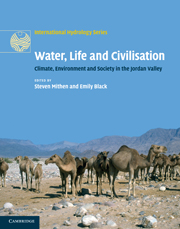Book contents
- Frontmatter
- Contents
- List of figures
- List of tables
- List of contributors
- Acknowledgements
- 1 Introduction: an interdisciplinary approach to Water, Life and Civilisation
- Part I Past, present and future climate
- Part II The palaeoenvironmental record
- 6 A review of palaeoclimates and palaeoenvironments in the Levant and Eastern Mediterranean from 25,000 to 5,000 years BP: setting the environmental background for the evolution of human civilisation
- 7 Palaeoenvironments of the southern Levant 5,000 BP to present: linking the geological and archaeological records
- 8 Using proxy data, historical climate data and climate models to investigate aridification during the Holocene
- 9 Palaeoenvironmental and limnological reconstruction of Lake Lisan and the Dead Sea
- Part III Hydrological studies of the Jordan Valley
- Part IV Human settlement, climate change, hydrology and water management
- Part V Palaeoeconomies and developing archaeological methodologies
- Part VI Society, economy and water today
- Part VII Conclusions
- Index
- Plate section
- References
6 - A review of palaeoclimates and palaeoenvironments in the Levant and Eastern Mediterranean from 25,000 to 5,000 years BP: setting the environmental background for the evolution of human civilisation
from Part II - The palaeoenvironmental record
Published online by Cambridge University Press: 26 April 2011
- Frontmatter
- Contents
- List of figures
- List of tables
- List of contributors
- Acknowledgements
- 1 Introduction: an interdisciplinary approach to Water, Life and Civilisation
- Part I Past, present and future climate
- Part II The palaeoenvironmental record
- 6 A review of palaeoclimates and palaeoenvironments in the Levant and Eastern Mediterranean from 25,000 to 5,000 years BP: setting the environmental background for the evolution of human civilisation
- 7 Palaeoenvironments of the southern Levant 5,000 BP to present: linking the geological and archaeological records
- 8 Using proxy data, historical climate data and climate models to investigate aridification during the Holocene
- 9 Palaeoenvironmental and limnological reconstruction of Lake Lisan and the Dead Sea
- Part III Hydrological studies of the Jordan Valley
- Part IV Human settlement, climate change, hydrology and water management
- Part V Palaeoeconomies and developing archaeological methodologies
- Part VI Society, economy and water today
- Part VII Conclusions
- Index
- Plate section
- References
Summary
ABSTRACT
The southern Levant has a long history of human habitation, and it has been previously suggested that climatic changes during the Late Pleistocene to Holocene stimulated changes in human behaviour and society. In order to evaluate such linkages it is necessary to have a detailed understanding of the climate record. We have conducted an extensive and up-to-date review of terrestrial and marine climatic conditions in the Levant and eastern Mediterranean during the past 25,000 years. We firstly present data from general circulation models (GCMs) simulating the climate for the Last Glacial Maximum (LGM), and evaluate the output of the model by reference to geological climate proxy data. We consider the types of climate data available from different environments and proxies and then present the spatial climatic ‘picture’ for key climatic events. This exercise suggests that the major Northern Hemisphere climatic fluctuations of the past 25,000 years are recorded in the eastern Mediterranean and Levantine region. However, this review also highlights problems and inadequacies with the existing data.
INTRODUCTION
The effects of global climate change on human society, on the environments we inhabit and on the sustainable development of our planet's poorest people are of prime concern to all. Predicting changes in water availability, local environments and climates will be the key to determining which areas of the world will require greatest assistance in dealing with increased global warmth and climate change in the coming century, and beyond. However, the detailed linkages between the development of human civilisation, anthropogenic activities, climate and environmental change remain poorly understood.
- Type
- Chapter
- Information
- Water, Life and CivilisationClimate, Environment and Society in the Jordan Valley, pp. 71 - 93Publisher: Cambridge University PressPrint publication year: 2011
References
- 2
- Cited by



